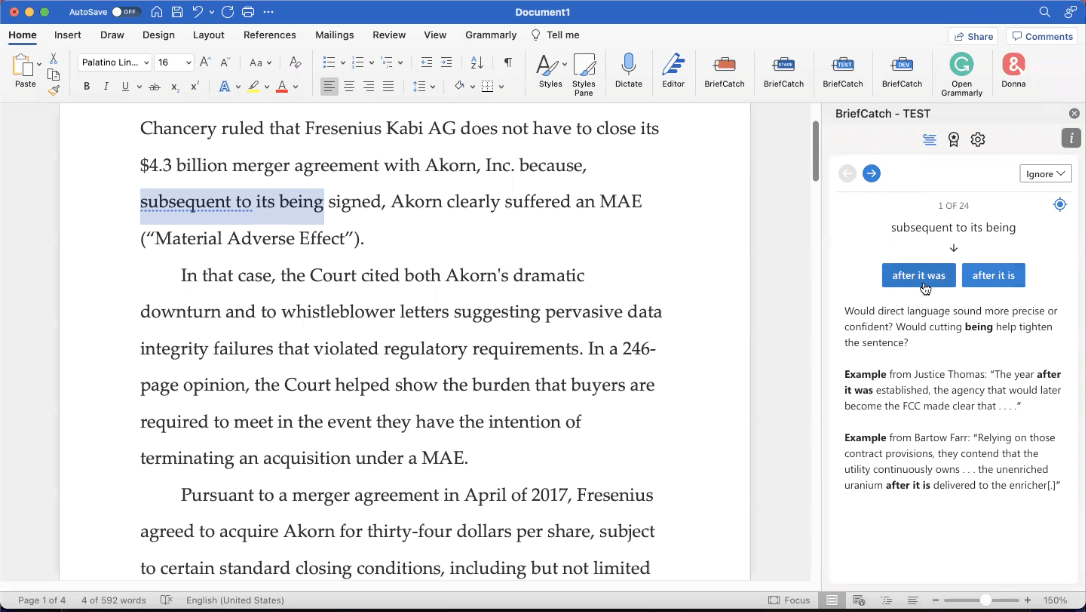
BriefCatch Citation Compliance: Complete Buyer's Guide
Automated citation checking and correction for legal documents
BriefCatch Citation Compliance represents a specialized legal AI solution focused exclusively on automated citation checking and correction for legal documents.
Market Position & Maturity
Market Standing
BriefCatch Citation Compliance occupies a unique niche within the rapidly expanding legal AI market, which is projected to grow from $1.45 billion in 2024 to $3.90 billion by 2030 at a 17.3% CAGR[1].
Longevity Assessment
The vendor's long-term viability assessment requires careful consideration given the specialized market focus and limited public information about business fundamentals.
AI Technology
BriefCatch Citation Compliance employs specialized AI algorithms designed specifically for legal citation recognition and correction, focusing on automated identification of citation errors and suggesting corrections based on established legal citation standards.
Architecture
The platform claims to integrate as an add-on functionality to existing document processing systems, suggesting a lightweight technical architecture designed for minimal workflow disruption.
Primary Competitors
Primary competitive alternatives include comprehensive platforms such as Spellbook, which offers compliance checks with audit trails[6][7], Kira Systems for due diligence capabilities[13][16], and LexisNexis for integrated legal research with regional compliance[26].
Competitive Advantages
Competitive advantages center on specialized citation focus that may provide deeper functionality and accuracy compared to general-purpose legal AI tools that include citation checking as one of many features.
Market Positioning
Market positioning reality reflects the trade-off between specialization depth and functionality breadth.
Win/Loss Scenarios
Win/loss scenarios likely favor BriefCatch Citation Compliance when citation accuracy is the primary concern and other legal AI needs are separately addressed or less important.
Key Features

Pros & Cons
Use Cases
Featured In Articles
Comprehensive analysis of AI Brief Compliance Checks for Legal/Law Firm AI Tools for Legal/Law Firm AI Tools professionals. Expert evaluation of features, pricing, and implementation.
How We Researched This Guide
About This Guide: This comprehensive analysis is based on extensive competitive intelligence and real-world implementation data from leading AI vendors. StayModern updates this guide quarterly to reflect market developments and vendor performance changes.
43+ verified sources per analysis including official documentation, customer reviews, analyst reports, and industry publications.
- • Vendor documentation & whitepapers
- • Customer testimonials & case studies
- • Third-party analyst assessments
- • Industry benchmarking reports
Standardized assessment framework across 8 key dimensions for objective comparison.
- • Technology capabilities & architecture
- • Market position & customer evidence
- • Implementation experience & support
- • Pricing value & competitive position
Research is refreshed every 90 days to capture market changes and new vendor capabilities.
- • New product releases & features
- • Market positioning changes
- • Customer feedback integration
- • Competitive landscape shifts
Every claim is source-linked with direct citations to original materials for verification.
- • Clickable citation links
- • Original source attribution
- • Date stamps for currency
- • Quality score validation
Analysis follows systematic research protocols with consistent evaluation frameworks.
- • Standardized assessment criteria
- • Multi-source verification process
- • Consistent evaluation methodology
- • Quality assurance protocols
Buyer-focused analysis with transparent methodology and factual accuracy commitment.
- • Objective comparative analysis
- • Transparent research methodology
- • Factual accuracy commitment
- • Continuous quality improvement
Quality Commitment: If you find any inaccuracies in our analysis on this page, please contact us at research@staymodern.ai. We're committed to maintaining the highest standards of research integrity and will investigate and correct any issues promptly.